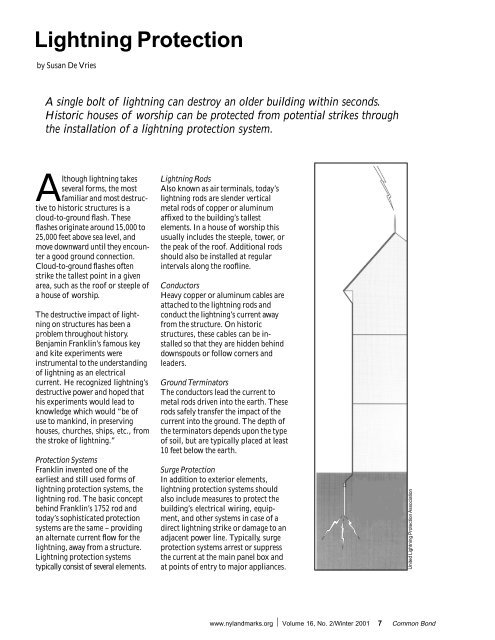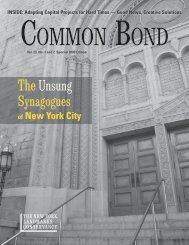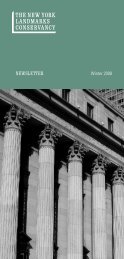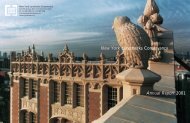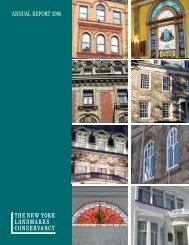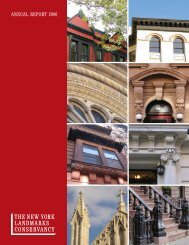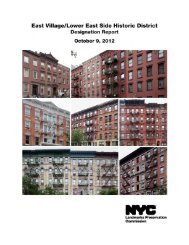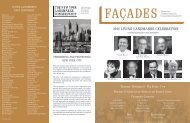Download Common Bond - The New York Landmarks Conservancy
Download Common Bond - The New York Landmarks Conservancy
Download Common Bond - The New York Landmarks Conservancy
You also want an ePaper? Increase the reach of your titles
YUMPU automatically turns print PDFs into web optimized ePapers that Google loves.
Lightning Protection<br />
by Susan De Vries<br />
A single bolt of lightning can destroy an older building within seconds.<br />
Historic houses of worship can be protected from potential strikes through<br />
the installation of a lightning protection system.<br />
Although lightning takes<br />
several forms, the most<br />
familiar and most destructive<br />
to historic structures is a<br />
cloud-to-ground flash. <strong>The</strong>se<br />
flashes originate around 15,000 to<br />
25,000 feet above sea level, and<br />
move downward until they encounter<br />
a good ground connection.<br />
Cloud-to-ground flashes often<br />
strike the tallest point in a given<br />
area, such as the roof or steeple of<br />
a house of worship.<br />
<strong>The</strong> destructive impact of lightning<br />
on structures has been a<br />
<strong>The</strong> problem throughout history.<br />
Benjamin Franklin’s famous key<br />
and kite experiments were<br />
instrumental to the understanding<br />
of lightning as an electrical<br />
current. He recognized lightning’s<br />
destructive power and hoped that<br />
his experiments would lead to<br />
knowledge which would “be of<br />
use to mankind, in preserving<br />
houses, churches, ships, etc., from<br />
the stroke of lightning.”<br />
Protection Systems<br />
Franklin invented one of the<br />
earliest and still used forms of<br />
lightning protection systems, the<br />
lightning rod. <strong>The</strong> basic concept<br />
behind Franklin’s 1752 rod and<br />
today’s sophisticated protection<br />
systems are the same – providing<br />
an alternate current flow for the<br />
lightning, away from a structure.<br />
Lightning protection systems<br />
typically consist of several elements.<br />
Lightning Rods<br />
Also known as air terminals, today’s<br />
lightning rods are slender vertical<br />
metal rods of copper or aluminum<br />
affixed to the building’s tallest<br />
elements. In a house of worship this<br />
usually includes the steeple, tower, or<br />
the peak of the roof. Additional rods<br />
should also be installed at regular<br />
intervals along the roofline.<br />
Conductors<br />
Heavy copper or aluminum cables are<br />
attached to the lightning rods and<br />
conduct the lightning’s current away<br />
from the structure. On historic<br />
structures, these cables can be installed<br />
so that they are hidden behind<br />
downspouts or follow corners and<br />
leaders.<br />
Ground Terminators<br />
<strong>The</strong> conductors lead the current to<br />
metal rods driven into the earth. <strong>The</strong>se<br />
rods safely transfer the impact of the<br />
current into the ground. <strong>The</strong> depth of<br />
the terminators depends upon the type<br />
of soil, but are typically placed at least<br />
10 feet below the earth.<br />
Surge Protection<br />
In addition to exterior elements,<br />
lightning protection systems should<br />
also include measures to protect the<br />
building’s electrical wiring, equip-<br />
Association<br />
ment, and other systems in case of a<br />
direct lightning strike or damage to an<br />
Protection<br />
adjacent power line. Typically, surge<br />
protection systems arrest or suppress<br />
Lightning<br />
the current at the main panel box and<br />
at points of entry to major appliances. United<br />
www.nylandmarks.org ⏐ Volume 16, No. 2/Winter 2001 7 <strong>Common</strong> <strong>Bond</strong>


